| Back Number | No.22 2005/08/17 | |||
| News | The EXPO 2005 Big Interchange - Earth Collaboration - LET’S SING TO THE EARTH’S SONG! Event Held |  |
||
| Pavilions | Korea Pavilion (Global Common 1) Sri Lanka Pavilion (Global Common 1) China Pavilion (Global Common 1) Bhutan Pavilion (Global Common 1) |
|||
| Column | Environmentally-green Measures at EXPO 2005 Aichi, Japan for Beating the Heat | |||
 |
|
The EXPO 2005 Big Interchange - Earth Collaboration - LET’S SING TO THE EARTH’S SONG! was held at EXPO 2005 Aichi, Japan between Thursday, July 21 and Saturday, July 23. Earth Collaboration - LET’S SING TO THE EARTH’S SONG! was held as part of EXPO 2005 Big Interchange, an event being held four times between May and August under the catchphrase, “LET’S MAKE THE FESTIVAL OF THE EARTH TOGETHER.” Festivals passed down in various parts of the world gather and create a new global festival with visitors to EXPO 2005 Aichi, Japan. The theme of the event held in May was, “LET’S DECORATE A FLOWER FLOAT!” and in June, the theme was “LET’S DANCE TO THE RHYTHM OF THE WORLD!” And the theme of the third event held in July was “LET’S SING TO THE EARTH’S SONG!” The voices and songs of the Earth, nurtured in various climates were performed at the event. Overseas performers at the event were the Ensemble Ene-sai from the Tuva Republic of the Russian Federation and Freaky Jesus & Cossiga from the Czech Republic, while Japanese performers were Koichi Makigami (super vocalist and President of the Japan Tuva Khoomei Association), Yuko Yokokawa and Akimi Fukushi (special female Japanese folk song duo), Seizan Matsuda (shakuhachi player), Moon Lighters’ ChinDon, and Kanie Bihachi Kai (Japanese folk songs and dance). |
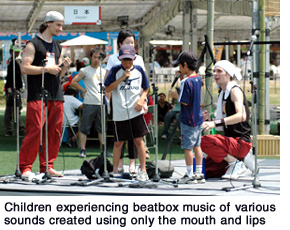 The Ensemble Ene-sai is a group from the Tuva Republic which is situated between Mongolia and Southern Siberia. It consists of four singers, including Khoomei singers (Tuvan throat-singing, which is a unique vocal style in which a person sings two different notes simultaneously) and three dancers. Freaky Jesus & Cossiga use only their voices to beat out rhythms. It is a vocal unit that is gathering global attention.
The Ensemble Ene-sai is a group from the Tuva Republic which is situated between Mongolia and Southern Siberia. It consists of four singers, including Khoomei singers (Tuvan throat-singing, which is a unique vocal style in which a person sings two different notes simultaneously) and three dancers. Freaky Jesus & Cossiga use only their voices to beat out rhythms. It is a vocal unit that is gathering global attention.The 21st, the first day of the event, began with a performance by Kanie Bihachi Kai which began from 11:30am. In the afternoon, visitors participated in a beatbox workshop at a corner of EXPO Plaza named “World Village,” in which rhythms and various sounds were made using just their mouths and lips. Tuvan throat-singing (Khoomei) was performed near visitors, and a workshop, in which there was interchange between people as they joined voices to try their hand at Khoomei together, as well as other events, was held. |
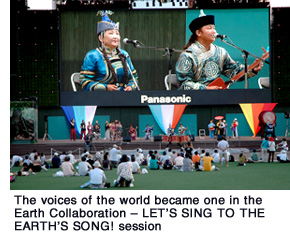 After the workshops, performers walked around the plaza with a new-generation Chindon-ya (groups who wear eye-catching costumes and parade around town playing musical instruments as a means of commercial advertisement) leading them in a parade unveiling the EXPO 2005 Big Interchange. They later went on stage to give diverse and enchanting performances. Visitors who had been able to experience various vocal methods at the workshop seemed to feel especially close to the performers as they enjoyed the show.
After the workshops, performers walked around the plaza with a new-generation Chindon-ya (groups who wear eye-catching costumes and parade around town playing musical instruments as a means of commercial advertisement) leading them in a parade unveiling the EXPO 2005 Big Interchange. They later went on stage to give diverse and enchanting performances. Visitors who had been able to experience various vocal methods at the workshop seemed to feel especially close to the performers as they enjoyed the show.The event continued until 8:00pm, with a Big Interchange Festival dance in which visitors joined in a Japanese Bon Festival dance around a festival scaffold. The fourth and last EXPO 2005 Big Interchange event themed “LET’S CELEBRATE LIFE!” will be held between Thursday, August 18 and Wednesday, August 24. Festivals of the world and Japan that honor the preciousness of life, including the Galungan-Kunigan, a festival from Bali - the island of gods and performing arts - in which prayers are given to household ancestors and spirits, and the Odalan, also of Bali, during which a parade of a gorgeous portable shrine takes place to the music of the Gamelan, as well as the Eisa festival of Okinawa and the bizarre Ushioni (ox devil) festival of Shikoku are scheduled to be shown at that time. |
![]()
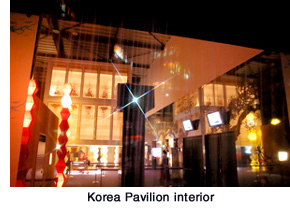 The theme of the Korea Pavilion is “Light of the Life.” The exhibition space is composed of exhibit corners in five colors that have symbolic meaning in Korea: blue, red, yellow, black and white.
The theme of the Korea Pavilion is “Light of the Life.” The exhibition space is composed of exhibit corners in five colors that have symbolic meaning in Korea: blue, red, yellow, black and white.A good blend of traditional Korean culture, sophisticated modern art and state-of-the-art technology at each exhibit corner move and awe visitors to the Korea Pavilion. When they place their hands over a screen of water in the Blue exhibit corner, visitors will be able to see animated fish swimming towards their fingertips. If they stand in front of a screen in the Black exhibit corner, they will see their shadows change into an ink-brush tree before their very eyes. In the White exhibit corner, thousands of pressed flowers on walls are softly lit by the many Korean paper lanterns hanging from the ceiling. It is then reflected on a mirrored floor, enchanting visitors with the mysterious space it creates. The strongest impression left to visitors to the Korea Pavilion is most likely “TREE ROBO” a 13-minute 3D animation shown in the pavilion’s theater. It is high-quality animation that tells the story of a boy who loves nature and a robot, who restore nature which has been destroyed through their friendship. Tears are often seen in the eyes of visitors at the end of this video. The Korea Pavilion is one that leaves visitors very satisfied. Those who visit this pavilion can fully understand the selection of this pavilion for the Gold Prize in the Nature’s Wisdom Award announced on May 26. |
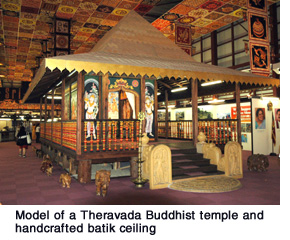 The Sri Lanka pavilion introduces the country’s natural environment and religious culture with a historical glory of creating unique art and architecture through Theravada Buddhist practice (an early form of Buddhism).
The Sri Lanka pavilion introduces the country’s natural environment and religious culture with a historical glory of creating unique art and architecture through Theravada Buddhist practice (an early form of Buddhism).Upon entering the Sri Lanka Pavilion, one of the striking features that visitors will notice is the colorful batik that covers the entire ceiling. Roughly 900 pieces of 1-meter-square batik have been joined together to create this huge work of art that is 1,000 square meters in size. The various designs dyed in rich hues such as red, yellow, orange and black depict many traditional motifs including plants, animals and the sun. The Theravada Buddhist temple recreated within the pavilion is decorated with Buddhist murals depicting the birth of Buddha and events related to Buddha’s life. It contains a statue of Buddha within. Other attractive features of the Sri Lanka Pavilion include demonstrations of Sri Lankan handcrafts where visitors can watch the making of brass craftwork and cotton textiles or the cutting of precious stones from a close distance. In this country where vocations are often hereditary, the legacy of masterful techniques is passed down from generation to generation, as can be seen in the expert skills of the craftsmen displaying their techniques in demonstrations. More than 30,000 precious lives were lost last December in Sri Lanka when the Tsunami in the Indian Ocean struck the country. Homes, beaches and trees were destroyed in an instant. It is the hope of the people working at the Sri Lanka Pavilion that scenes of them trying their best at EXPO 2005 Aichi, Japan will be seen through media coverage and enhearten the people of their nation who are still working towards reconstruction of devastated areas. |
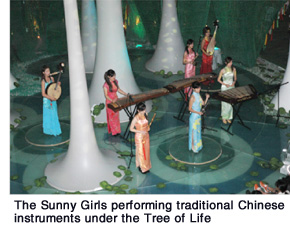 The façade of the China Pavilion is dynamically decorated with paper cutout designs of the 12 animals - such as a dragon and tiger - of the Chinese zodiac which are depicted on red panels. The theme of the pavilion is “Nature, City, Harmony - the Art of Life.”
The façade of the China Pavilion is dynamically decorated with paper cutout designs of the 12 animals - such as a dragon and tiger - of the Chinese zodiac which are depicted on red panels. The theme of the pavilion is “Nature, City, Harmony - the Art of Life.”The Tree of Life, a monument made of paper situated in a part of the pavilion that rises through the second story, represents the moment that a spray of water bounces up or a plant’s leaf grows. Under the Tree of Life, the beautiful sounds of traditional instruments, such as the erhu, pipa, flute, dulcimer, ruan and zheng, and the dignified air of the Sunny Girls, an eight-member female musical ensemble, enchant visitors eight times a day. With the Tree of Life at the center, a gradual spiral slope extends to the second floor. A beautiful relief on the wall represents process of Chinese development over its 5,000 year history, from antiquity to today’s modern cities. 11 video monitors set up on the wall show promotional footage of China’s 13 provinces and their cities. The slope is designed to offer an experience akin to walking in a time tunnel of the long history of Chinese civilization as visitors climb up. On the second floor is the Sandalwood Study. Beautifully luxurious sandalwood furniture beloved since ancient times by emperors and the aristocracy are on display here, and the beautiful luster of the wood and elaborate carvings of the many items on display draw the eyes of visitors. Next to the Sandalwood Study is the Crystal Cinema, which doubles as an introduction of EXPO 2010 Shanghai. A three-sided screen displays majestic scenes of nature as well as cityscapes of Shanghai, one after another. It enables visitors to experience the moment when there is harmony between nature and the city. From Aichi to Shanghai, the concept of the exhibits at the China Pavilion will be passed on to the theme of EXPO 2010 Shanghai, which is “Better city, Better life.” |
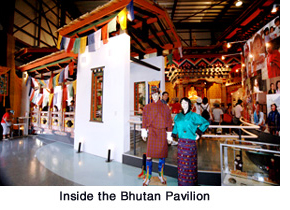 The Kingdom of Bhutan is a small country with a population of about 700,000, nestled at the base of the eastern Himalayas. The theme of the Bhutan Pavilion is “Art of Life.” A roofed cantilever bridge, built through traditional construction methods, not only welcomes visitors who enter the Bhutan Pavilion but also symbolizes Bhutan’s link with the international community and the world.
The Kingdom of Bhutan is a small country with a population of about 700,000, nestled at the base of the eastern Himalayas. The theme of the Bhutan Pavilion is “Art of Life.” A roofed cantilever bridge, built through traditional construction methods, not only welcomes visitors who enter the Bhutan Pavilion but also symbolizes Bhutan’s link with the international community and the world.After crossing the bridge, visitors will be struck by a grand and elaborate mural, fashioned after a Buddhist monastery, which took three months to make by 15 craftsmen in Bhutan and required two months to assemble at the pavilion. A colorful vermillion world with elements of green and yellow fill the interiors of the Bhutan Pavilion. Kept inside the Namgyel Khangzang, said to represent the sacred abode of gods and goddesses, is a golden statue of Bhudda about two meters in size. The Thongdroel, a 6 meter high and 4.5 meter wide image of Buddha and two disciples expressed in the form of sacred appliqué and embroidery, also quietly welcomes visitors to the pavilion. The majority of the Bhutanese population is farmer or pastoral farmer, and the lives of the people are always linked with nature. Pavilion visitors will be able to come to know the daily lives of the people nestled in the Himalayas through the depictions shown on the layers of cloth that are hung from the ceiling, as well as the numerous photographs on exhibit. Also of interest are exhibits of rare herbs, as well as those of bamboo and wooden living ware, such as those for enjoying salted butter tea called Suja. The Bhutan Pavilion enables visitors to experience the rich spiritual world of the Bhutanese, whose lives are focused around Buddhism and living in harmony with nature. |
![]()
 |
|
With summer in full swing, temperatures at the EXPO 2005 Aichi, Japan are becoming more intense. Measures to ward off the heat have therefore being taken at EXPO 2005, providing a comfortable environment to people visiting the venue. It should be noted that through these measures, EXPO 2005 is also playing a role as proving grounds for valuable new technology that will contribute to the birth of an environmentally sustainable society from the viewpoint of fighting the heat. |
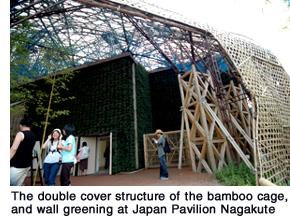 There are three pavilions at EXPO 2005 Aichi, Japan being exhibited by the Government of Japan. They are the Japan Pavilion Nagakute, Japan Pavilion Seto, and Japan Pavilion on the Web (CYBER NIPPON-KAN). Measures to ward off the heat have been taken at both the Nagakute and Seto pavilions utilizing the latest in technology, which also makes full use of age-long Japanese wisdom, and are being monitored 24 hours a day and reported at the CYBER NIPPON-KAN.
There are three pavilions at EXPO 2005 Aichi, Japan being exhibited by the Government of Japan. They are the Japan Pavilion Nagakute, Japan Pavilion Seto, and Japan Pavilion on the Web (CYBER NIPPON-KAN). Measures to ward off the heat have been taken at both the Nagakute and Seto pavilions utilizing the latest in technology, which also makes full use of age-long Japanese wisdom, and are being monitored 24 hours a day and reported at the CYBER NIPPON-KAN.For example, Japan Pavilion Nagakute is enclosed by a giant “cage” made of smoke-cured bamboo that is woven using the six-knot weaving technique. This bamboo cage reduces the thermal load on the structure within it by shading it from direct sunlight, and it creates an environment like that in the shade of a tree where natural breezes flow through. According to data announced by and published on CYBER NIPPON-KAN as of noon, Wednesday, August 17, the amount of solar radiation on the outer bamboo cage was 0.82kW/m2, while it was 0.42kW/m2 within the bamboo cage, a difference of 0.4kW/m2. This kind of data is being transmitted 24 hours a day through the “Monitoring the Japan Pavilions!” corner of the Japan Pavilion on the Web. Other measures being taken at Japan Pavilion Nagakute include photocatalytic plate steel roofing. Wastewater sprinkled on the roof spreads and evaporates, cooling the structure. (For details, please refer to the Pavilion section of Issue No.3 of the EXPO 2005 Aichi, Japan E-mail Newsletter.) The wall greening of front of Japan Pavilion Nagakute, which faces south, also helps to reduce the thermal load on the building by bringing down the temperature of the wall. The “Monitoring the Japan Pavilions!” corner also continually provides data regarding the impact of these measures. |
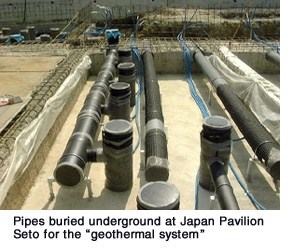 The geothermal system being used as one of the measures against heat at Japan Pavilion Seto is also quite interesting. Pipes have been laid 4.5 meters deep in the ground. Outside air is piped through the geopipes and cooled and circulated throughout the pavilion. Variations in temperatures underground are minimal, and it provides stable natural energy - which is free and provides unlimited heating or cooling - without being affected by the outside weather. This system, utilizing geo-heat makes it possible to greatly reduce the burden being placed on air conditioning and leads to the reduction of CO2 emissions making it a green system that is friendly to the Earth’s environment.
The geothermal system being used as one of the measures against heat at Japan Pavilion Seto is also quite interesting. Pipes have been laid 4.5 meters deep in the ground. Outside air is piped through the geopipes and cooled and circulated throughout the pavilion. Variations in temperatures underground are minimal, and it provides stable natural energy - which is free and provides unlimited heating or cooling - without being affected by the outside weather. This system, utilizing geo-heat makes it possible to greatly reduce the burden being placed on air conditioning and leads to the reduction of CO2 emissions making it a green system that is friendly to the Earth’s environment.For your information, the outside temperature as of noon on Wednesday, August 17 was 29.9 degrees Centigrade, and the underground temperature was 15.2 degrees C. The temperature of the air being circulated after passing through the geopipes was 25.7 degrees. Simply passing air through pipes underground reduced the temperature by 4.2 degrees C. Another measure taken at Japan Pavilion Seto is the use of auto-responsive sun-sensor glass. When the outside temperatures go beyond about 30 degrees Centigrade, the transparent glass turns translucent and shuts out about 80 percent of the sun’s rays. The amount of solar radiation is measured both on the outside and inner surface of the glass. Cutting-edge technology being utilized to ward off the heat can also be found at various other areas of EXPO 2005. |
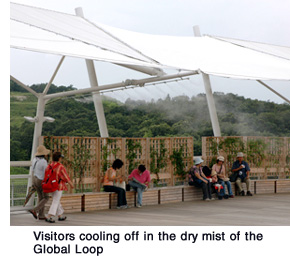 Dry mist being sprayed under canopies at the Global Loop provides comfortable coolness for visitors traveling on the elevated corridor that goes around the venue. Set up at a total of about a quarter of the Global Loop, the dry mist is sprayed from 1,824 nozzles at each location. However, because the mist’s particle size is only 16/1000th of a millimeter, it evaporates before it can wet the faces or clothes of visitors passing underneath. Furthermore, it is superior in that its energy consumption is extremely low. It is technology said to have been put to practical use for the first time at EXPO 2005.
Dry mist being sprayed under canopies at the Global Loop provides comfortable coolness for visitors traveling on the elevated corridor that goes around the venue. Set up at a total of about a quarter of the Global Loop, the dry mist is sprayed from 1,824 nozzles at each location. However, because the mist’s particle size is only 16/1000th of a millimeter, it evaporates before it can wet the faces or clothes of visitors passing underneath. Furthermore, it is superior in that its energy consumption is extremely low. It is technology said to have been put to practical use for the first time at EXPO 2005.Various pavilions besides the Japan Pavilions have also taken measures to beat the heat. EARTH TOWER NAGOYA CITY, the pavilion of Nagoya City, has an Aqua Wall which flows down the tower walls, and 54% of Mitsubishi Pavilion @Earth is covered with plants. The heat of evaporation, plants and various other ingenious methods are being used to lower temperatures. Meanwhile, there are also efforts such as the photocatalytic canopies at the JR Central Pavilion and rest stations at Global Common 4, the dry mist at Wonder Circus - Electric Power Pavilion, the Aqua Wall at the MITSUI-TOSHIBA Pavilion, the “green” rooftop at the GAS PAVILION and the mist at the Japanese Garden. EXPO 2005 is proving to be a valuable opportunity to showcase and allow visitors to experience a summer of the future that is made possible by environmentally-friendly cutting-edge technology. |
| EXPO 2005 AICHI, JAPAN Newsletter | |
| To read past issues:Back Number | |
| Editor/Publisher: Japan Association for
the 2005 World Exposition Head Office: 1533-1 Ibaragabasama, Nagakute-cho Aichi 480-1101 Japan Nagoya Office: Nagoya Daiya II Bldg 4F, 3-15-1 Meieki Nakamura-ku, Nagoya, Aichi 450-0002 Japan Tokyo Office: Iino Bldg 8F, 2-1-1 Uchisaiwai-cho Chiyoda-ku, Tokyo 100-0011 Japan |
 |
© Japan Association for the 2005 World Exposition
